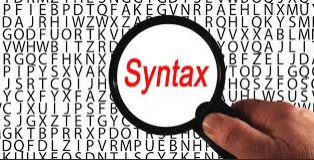There are several different definitions about syntax according to online dictionaries and experts.
Syntax according to online dictionaries :
- Collinsdictionary.com : Syntax is the ways the words can be
put together, or are put together, in order to make sentences.
- Dictionary.com : The study of the rules and patterns by
which sentences and phrases are formed in a language.
- Merriam-webster.com : The way in which linguistic elements
(such as words) are put together to form constituents (such as phrases or
clauses).
Syntax according to experts/linguist :
- Gleason (1955) : Syntax maybe roughly defined as the
principlesof arrangement ofthe construction (word) into large construction of
various kinds.
- Krisdalaksana (1993) : The syntax in a language subsystem
that includes words that are often considered part of grammar, namely
morphology and the branch of lingustics that studies words.
- Arifin (2009) : Syntax is sub-dicipline of linguistics that studies the relationship between words in speech include phrases structure, clause structure, and sentence structure in a language. Syntax refers to the set of rules that govern sentence structure in a language. It determines how words and phrases are arranged to form grammatically correct and meaningful sentences.
Here are some important about syntax :
1. Word order : Different language have different word
orders. For example, English typically follows subject-verb-object (SVO) word
order, whereas a language such as Japanese may use subject-object-verb (SOV)
word order.
2. Parts of speech : The words in a sentence are categorized
into parts of speech, such as nouns, verbs , adjectives, adverbs, prepositions,
conjunctions, and pronouns. The order and arrangement of these parts of speech
follow certain rules.
3. Agreement : In many language, there must be agreement
between the different of parts of sentence subject-verb agreement or
adjective-noun agreement. This mean that the words in a sentences must match in
number, gender, and other grammatical characteristics.
4. Punctuation : Punctuation mark, such as periods, commas,
semicolons, and question mark, play an important role in indicating the
structure and meaning of sentences.
5. Tense and Aspect : The choice of verb tense (past,
present, future) and aspect (simple, continuous, perfect) affects the syntax of
a sentence and its meaning.
6. Ambiguity : Syntax can be also a source of ambiguity in
language, where where the same words can be arranged in different ways to
convey differents meanings.
7. Syntax in Programming : In the context of computer programming, syntax refers to the rules that goven the structure of code in particular programming language. Syntac errors in code can cause program failure.
There are 4 structure of sentences :
A. Word Class : Noun/n, Verb/v, Adjective/adj, Adverb/adv,
Preposition/pre, Conjunction/conj, Pronouns/pro.
B. Phrases Class : Compound word (penggabungan), non
predicative (gabungan kata yang tidak memiliki inti kalimat).
- Noun phrases/NP : For example, hardworker (adj+n).
- Verb prhases/VP : For example, work hard (v+adj).
- Adjective phrases/AdjP : For example, too hard (adv+adj).
- Adverb phrases/AdvP : For example, too hardly (adv+adv).
- Preposition phrases/PreP : For example, at work (pre+n).
C. Clause : Syntatic unit/predicative
What are independent clauses?
Because an independent clause contains both a subject and a verb, a
single independent clause is a simple sentence, the most basic type of
sentence. However, you can also combine two or more independent clauses to
creat a compound sentence.
For example : Next Tuesday will be my first day at my new job.
What are dependent clauses?
Dependent clauses are a little more complicated. Also knowna as
subordinate clauses, Dependent clauses alone are not complete sentences, even
though they have both a subject and verb. Dependent clauses need to join with
an independent clause to be correct, hence the name dependent.
For example : If the interview goes well.
D. Sentence : Syntatic unit/predicate > clause. A sentence
is a complete group of words, usually, containing a subject and a predicate,
conveying a statement, question, exclamation, or command, and consistingof a
main clause and sometimesone or more subordinate clause.
There are 4 types of sentences :
1. Simple sentence : A simple sentence is a sentence
containing only one clause, or more specifically, an independent clause, with a
subject and predicate.
For example : I am a student.
2. Compound sentence : A compound sentence is a sentence that
connect two independent clauses, typically with a coordinating conjunction.
For example : I go to campus because I am a student.
3. Complex sentence : A complex sentence combines and
independent clause with one or more dependent clause.
For example : Because I am a student, I go to campus.
4. Compound complex sentence : A compound complex sentence
has two or more independent clause and at least one dependent clause.
For example : Because I am a student, I go to campus in order to get
my bright future.
Thus, syntax is basic for understanding how language structure
works, both in the connect of human language and in computer programming. This
helps in effective communication and also can be creating well-functioning
programs.
Written by:
Rifdah Takwin, Nurhidayah, Mawar, Nurul Inayah, Fauziah Jeihan
Kelas A-2023


